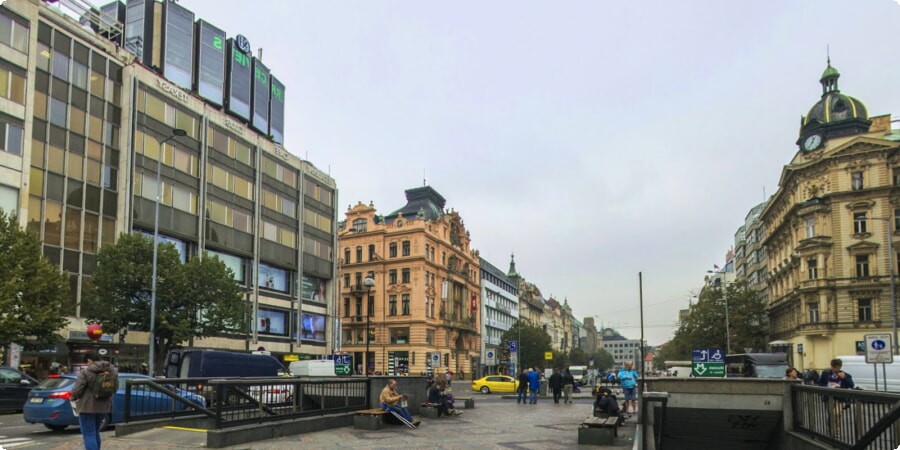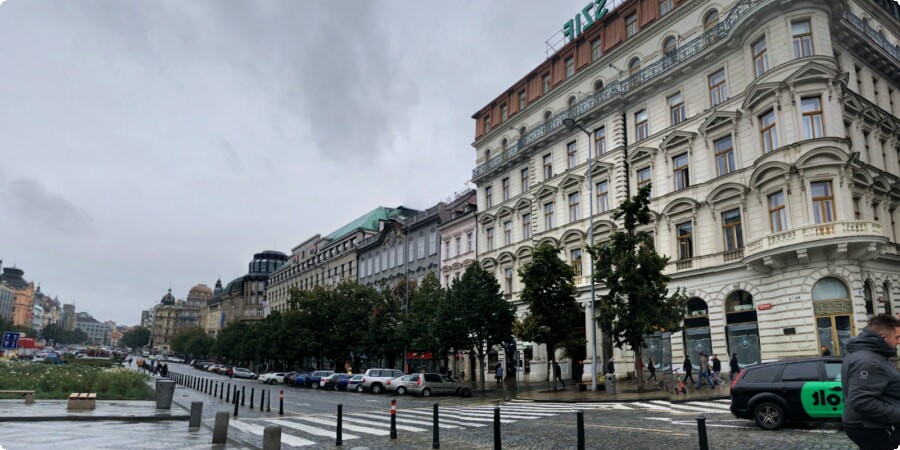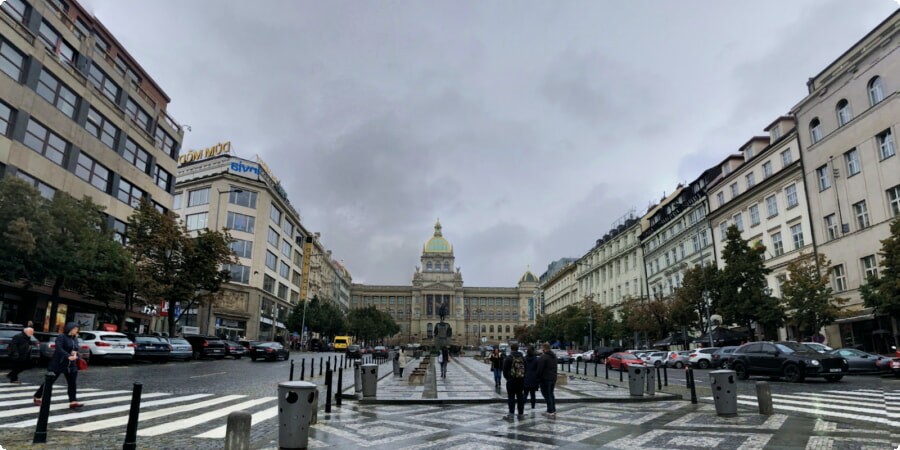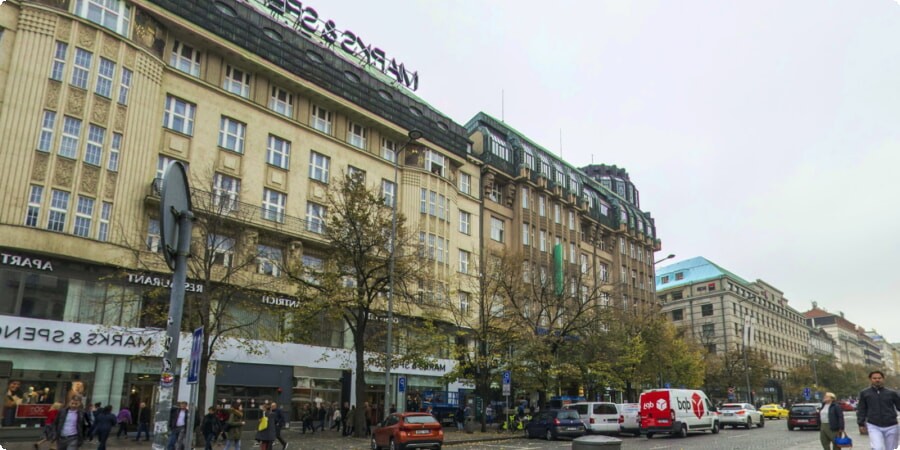Wenceslas Square, or Václavské náměstí as it’s known in Czech, stands as one of Prague’s most vibrant and historically significant landmarks. Nestled in the heart of the New Town (Nové Město), this grand boulevard stretches over 750 meters and serves as the focal point of both the city’s commercial activity and its historical narrative.
At its core, Wenceslas Square is more than just a bustling thoroughfare; it is a living testament to Prague’s rich history and cultural evolution. From its medieval roots to its modern-day role as a major commercial and social hub, the square is where Prague’s past and present intersect. Its broad, open space is a stage for public gatherings, protests, celebrations, and everyday life, making it a microcosm of the city’s spirit.
A stroll through Wenceslas Square reveals a blend of historical architecture and contemporary businesses. It’s a place where the hustle and bustle of modern life merge seamlessly with the echoes of significant historical events. Whether you're shopping, dining, or simply soaking in the atmosphere, Wenceslas Square offers a unique glimpse into Prague's heart.
For a visual preview of Wenceslas Square, check out its location on Google Maps.
Historical Background
The history of Wenceslas Square is as dynamic as the square itself. Originally established in the 14th century by Charles IV, the square was initially designed as a marketplace and a center for trade. Its strategic location and broad design quickly made it a central gathering place in the New Town.
Throughout the centuries, Wenceslas Square has witnessed many pivotal moments in Czech history. During the 19th and early 20th centuries, it became a hotspot for political and social movements. One of the most notable events was the Velvet Revolution of 1989, a peaceful protest that led to the end of communist rule in Czechoslovakia. This pivotal moment was marked by the gathering of thousands of people in the square, symbolizing the collective desire for change and freedom.
The square also played a significant role during the Nazi occupation of Czechoslovakia. It was here that the public demonstrated their resistance against the regime and their solidarity with the Jewish population. The events of World War II and the post-war era continued to shape the square’s role in Prague's collective memory.
For more historical context, you can explore the detailed history of Wenceslas Square on Wikipedia.

Architectural Highlights
The architecture of Wenceslas Square is a fascinating journey through different historical periods, reflecting the evolution of Prague itself. As you walk down the boulevard, you'll encounter a mix of grand historical buildings and modern structures, each contributing to the square’s unique character.
At the northern end of the square stands the National Museum (Národní muzeum), a monumental Neo-Renaissance building that dominates the skyline. Established in 1818, the museum houses a vast collection of artifacts and exhibits that trace the history of the Czech lands. Its imposing façade and grand staircase are iconic symbols of Czech cultural heritage. For a closer look at the National Museum, visit its Wikipedia page.
Another architectural gem is the statue of Saint Wenceslas, the patron saint of Bohemia, which is positioned prominently on horseback at the southern end of the square. Created by sculptor Josef Václav Myslbek, the statue was erected in 1912 and has become a powerful symbol of Czech nationalism and pride.
Throughout the square, you'll also find a variety of architectural styles, from Art Nouveau to contemporary designs. The juxtaposition of these styles provides a visual representation of Prague’s rich architectural heritage. Notable buildings include the grand Hotel Europa and the sleek design of the Lucerna Palace.
To fully appreciate the architectural beauty of Wenceslas Square, consider booking a car to explore not just the square, but also other notable sites in Prague and the surrounding areas. Renting a car offers flexibility and convenience, allowing you to experience Prague at your own pace. You can arrange a car rental through CarsCombined to enhance your travel experience.
The Role in Prague’s Modern Life
Wenceslas Square is more than just a historical landmark; it is a vibrant epicenter of modern life in Prague. As you walk along the square, you’ll experience a lively mix of commercial, social, and cultural activities that define contemporary Prague.
The square is lined with a variety of shops, from high-end boutiques to popular international chains, making it a prime destination for shopping enthusiasts. Whether you’re in search of the latest fashion trends or unique souvenirs, Wenceslas Square offers a diverse retail experience.
In addition to shopping, the square is home to numerous restaurants, cafés, and bars. Here, you can enjoy a leisurely meal, savor traditional Czech dishes, or simply sip a coffee while watching the world go by. The bustling atmosphere of the square is a perfect backdrop for enjoying Prague’s culinary scene.
Cultural events and public gatherings also frequently take place on Wenceslas Square. From street performers to seasonal festivals, there’s always something happening. The square’s open space and central location make it an ideal venue for events that draw both locals and tourists.
For a comprehensive guide to dining, shopping, and entertainment options around Wenceslas Square, consider exploring local recommendations and reviews.

Significant Historical Events
Wenceslas Square has been a witness to many of the key moments in Czech history. It has played a crucial role in shaping the political and social landscape of Prague and beyond.
One of the most significant events in recent history was the Velvet Revolution of 1989. This peaceful movement, which culminated in the square, marked the end of communist rule in Czechoslovakia. The square became a focal point for the protests, where thousands of Czechs gathered to demand democratic reforms and freedom. The Velvet Revolution remains a powerful symbol of the Czech Republic’s transition to democracy.
Another notable event was the Prague Spring of 1968. During this period, Wenceslas Square saw protests against the Soviet-led Warsaw Pact invasion. The square served as a stage for demonstrations and speeches advocating for political reform and freedom, reflecting the deep desire for change within the Czech population.
Historical events like these underscore the square’s importance as a place of collective action and reflection. Wenceslas Square continues to be a site of remembrance and celebration, reflecting the dynamic history of Prague.
For more information on the Velvet Revolution and the Prague Spring, you can visit their respective Wikipedia pages and Wikipedia page.
Cultural and Social Activities
Wenceslas Square is a hub of cultural and social activities, offering a rich array of experiences throughout the year. Its central location makes it an ideal spot for a variety of public and private events.
Throughout the year, the square hosts numerous festivals and cultural events. From Christmas markets that fill the square with festive lights and local crafts to summer festivals featuring music, dance, and food, there’s always something to see and do. The square’s events often reflect the vibrant cultural scene of Prague, showcasing local traditions and international influences.
Public gatherings and demonstrations are also common at Wenceslas Square. The square’s history as a site for political activism continues today, with various groups using the space to voice their causes and engage with the public.
For a more immersive experience, you might want to explore Prague’s cultural offerings beyond the square. Booking a car can provide the flexibility to visit other nearby attractions and cultural sites throughout the Czech Republic. You can arrange a car rental through CarsCombined to enhance your travel experience and discover the diverse cultural landscape of the region.

Visiting Wenceslas Square: Practical Tips
When planning a visit to Wenceslas Square, there are several practical considerations to ensure a smooth and enjoyable experience.
Best Times to Visit: Wenceslas Square is a bustling area that is active throughout the day and night. To avoid the largest crowds, try to visit during the early morning or late afternoon. However, experiencing the square during peak hours can also be rewarding, as it is the most vibrant and full of life.
Transportation Options: The square is centrally located and easily accessible by various means of transportation. If you're traveling from other parts of Prague, the metro station at Wenceslas Square (Můstek) provides convenient access. Trams and buses also service the area, making it easy to reach from different parts of the city.
Nearby Attractions: While Wenceslas Square itself is a major attraction, it is also surrounded by other notable sites. Just a short walk away, you can explore the historic National Museum, enjoy the architecture of the State Opera, or wander through the picturesque streets of the New Town.
Dining and Shopping: The square is surrounded by numerous shops, cafes, and restaurants. For a taste of local cuisine, try one of the traditional Czech restaurants or grab a snack from a street vendor. Shopping enthusiasts will find a mix of international brands and unique local boutiques.
For a more comfortable and flexible travel experience, consider booking a rental car. This allows you to explore not just Wenceslas Square but also other attractions in and around Prague at your own pace. You can arrange a car rental through CarsCombined.
Wenceslas Square in Popular Culture
Wenceslas Square has left an indelible mark on popular culture, both in Czech and international media. Its iconic status has made it a frequent subject in various forms of artistic expression.
Literature and Film: The square has been depicted in numerous works of literature and film. It often serves as a backdrop for stories set in Prague, capturing the essence of the city’s vibrant and historic atmosphere. Films and books that feature the square provide a glimpse into its cultural significance and its role in the city's identity.
Media and Music: Wenceslas Square has also appeared in songs and television programs, reflecting its influence on contemporary culture. It symbolizes Prague’s dynamic character and serves as a cultural touchstone for both locals and visitors.
The square’s role in popular culture underscores its importance as a symbol of Prague’s historical and modern identity. It continues to inspire artists, filmmakers, and writers, reinforcing its status as a central element of the city’s cultural landscape.

Future Developments and Preservation Efforts
The preservation and development of Wenceslas Square are crucial in maintaining its historical integrity while accommodating modern needs. Ongoing efforts focus on enhancing the square’s infrastructure and ensuring that it continues to be a vibrant and functional space for all.
Preservation Projects: The city of Prague is committed to preserving the historical and architectural heritage of Wenceslas Square. This includes restoring historic buildings, maintaining the square’s public spaces, and addressing any issues related to wear and tear. These preservation efforts are essential in protecting the square’s unique character for future generations.
Future Developments: Plans for future developments aim to enhance the square’s functionality and accessibility while respecting its historical significance. This may involve upgrading public facilities, improving pedestrian pathways, and incorporating green spaces. These developments are designed to ensure that Wenceslas Square remains a central and dynamic part of Prague’s urban landscape.
By supporting these preservation and development efforts, visitors can contribute to maintaining the square’s role as a key cultural and historical landmark. Wenceslas Square continues to evolve, reflecting both the city’s rich past and its aspirations for the future.